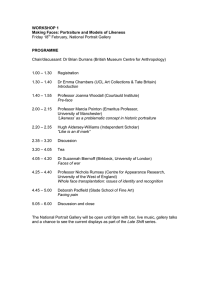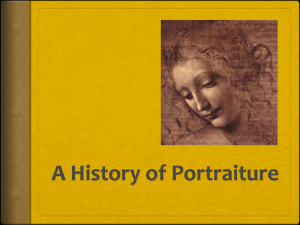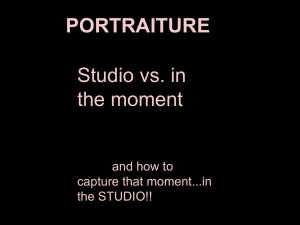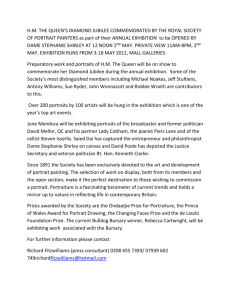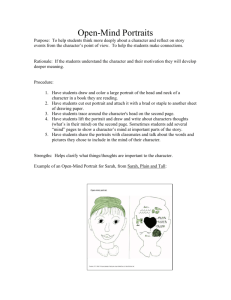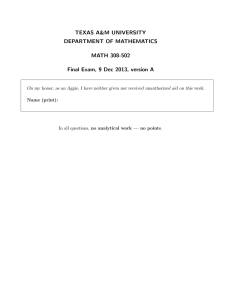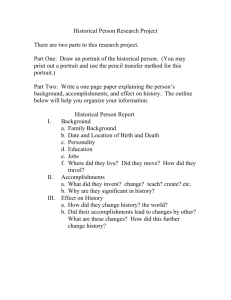WORKSHOP 1 ABSTRACTS JOANNA WOODALL (Courtauld Institute)
advertisement
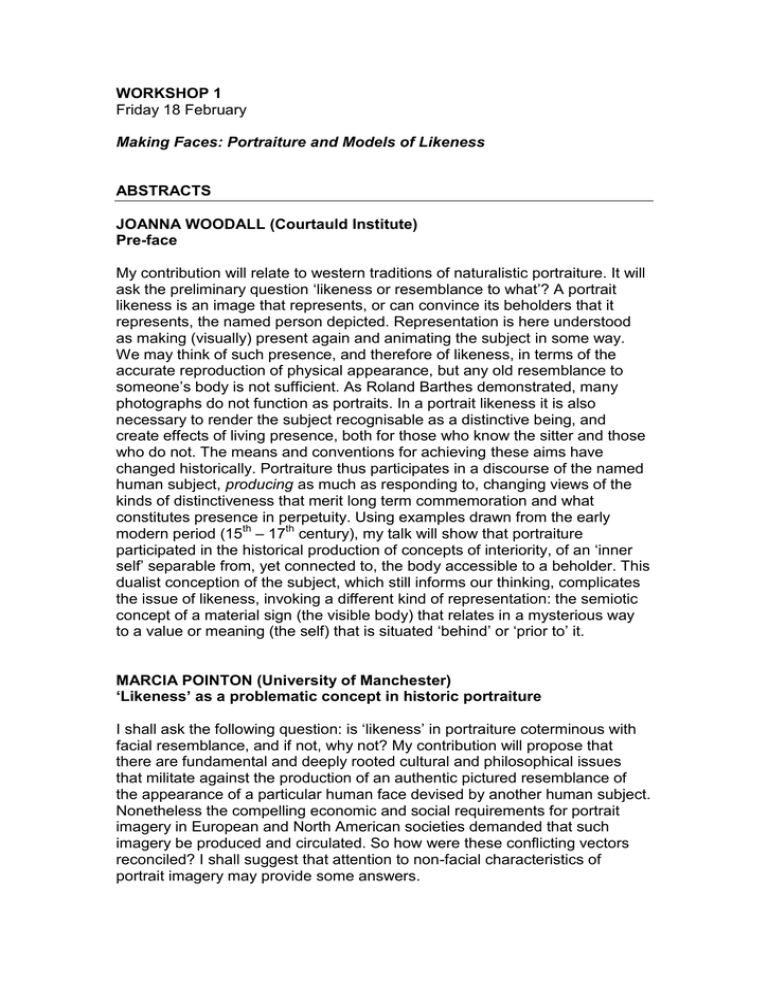
WORKSHOP 1 Friday 18 February Making Faces: Portraiture and Models of Likeness ABSTRACTS JOANNA WOODALL (Courtauld Institute) Pre-face My contribution will relate to western traditions of naturalistic portraiture. It will ask the preliminary question ‘likeness or resemblance to what’? A portrait likeness is an image that represents, or can convince its beholders that it represents, the named person depicted. Representation is here understood as making (visually) present again and animating the subject in some way. We may think of such presence, and therefore of likeness, in terms of the accurate reproduction of physical appearance, but any old resemblance to someone’s body is not sufficient. As Roland Barthes demonstrated, many photographs do not function as portraits. In a portrait likeness it is also necessary to render the subject recognisable as a distinctive being, and create effects of living presence, both for those who know the sitter and those who do not. The means and conventions for achieving these aims have changed historically. Portraiture thus participates in a discourse of the named human subject, producing as much as responding to, changing views of the kinds of distinctiveness that merit long term commemoration and what constitutes presence in perpetuity. Using examples drawn from the early modern period (15th – 17th century), my talk will show that portraiture participated in the historical production of concepts of interiority, of an ‘inner self’ separable from, yet connected to, the body accessible to a beholder. This dualist conception of the subject, which still informs our thinking, complicates the issue of likeness, invoking a different kind of representation: the semiotic concept of a material sign (the visible body) that relates in a mysterious way to a value or meaning (the self) that is situated ‘behind’ or ‘prior to’ it. MARCIA POINTON (University of Manchester) ‘Likeness’ as a problematic concept in historic portraiture I shall ask the following question: is ‘likeness’ in portraiture coterminous with facial resemblance, and if not, why not? My contribution will propose that there are fundamental and deeply rooted cultural and philosophical issues that militate against the production of an authentic pictured resemblance of the appearance of a particular human face devised by another human subject. Nonetheless the compelling economic and social requirements for portrait imagery in European and North American societies demanded that such imagery be produced and circulated. So how were these conflicting vectors reconciled? I shall suggest that attention to non-facial characteristics of portrait imagery may provide some answers. HUGH ALDERSEY-WILLIAMS (Independent Scholar) “Like is an ill mark” This presentation will discuss aspects of personal identity, representation and likeness through the personal examples selected for display at the 2009-10 Wellcome Collection exhibition: 'Identity: Eight Rooms, Nine Lives'. The largely intuitive process of selection by the curators examples and visitors' response to them powerfully inform theoretical notions of identity. These subjects included an actor, an artist, diarists, a pair of twins and leading scientists involved in the science of identity. The media through which these people's personalities were represented ranged from painting and photography (portrait and self-portrait) to diaries, video diaries, press reports, fingerprints, brain scans and DNA profiles. In each case, personal identity is shown to be more multilayered and ambiguous than we tend to assume it to be. For example, the twins presented in the exhibition were in fact born more than two years apart (due to IVF), which immediately challenges our assumption of what it means to be a twin, what that means for individual personality, and even the meaning of the word twin. I will also look at cases where intervening time and distance problematize personal identity with reference to literary and historical accounts including cases of absence and return, where acceptance and recognition are not always in agreement. At the heart of these cases is the fact that 'identity' established by others is always and necessarily a reduction - sometimes insultingly so - of the person. Fingerprints, photographs, PIN numbers and DNA profiles vary in their acceptability according to context, but all are severe abbreviations of the self. What is lost in these processes and what are the implications of this reduction for the individual and for society. The self-portrait maybe more 'complete', but raises other questions of intentionality. What are the important differences between a self-portrait and the portrait of another? Are there circumstances in which a 'neutral' portrait is possible? SUZANNAH BIERNOFF (Birkbeck, University of London) Faces of war This paper compares the portrayal of facial injury during the First World War to contemporary photographs of veterans injured in Iraq and Afghanistan. One of the most poignant innovations of the Great War was the production of portrait masks for severely disfigured servicemen: the surgical ‘failures’. In London and Paris, professional sculptors were responsible for the provision of these delicate masks, and their results are recorded in the photographs of British home front photographer Horace Nicholls and in a silent film of Anna Coleman Ladd at work in her American Red Cross studio in Paris. Both sources document the artistry of prosthetic repair, and Nicholls’ images dramatize the psychological impact of facial mutilation – regarded by many to be the most dehumanizing of injuries. Paradoxically, though, the juxtaposition of human face and portrait mask disturbs the equation of identity and appearance on which traditional portraiture depends. Given the professed ‘death of the portrait,’ one might expect a different treatment of disfigurement today; a loosening of the conviction that appearance and identity are relatively fixed; a more dispersed conception of personhood. Images from recent conflicts do not bear this out, however, and the representation of disfigured veterans (indeed, disfigurement of any sort) in the press and popular culture remains convention-bound. We will look at the work of two contemporary photographers, one American, one British, whose portraits of veterans challenge the usual narratives of sacrifice, courage and redemption – including the fantasy of repair. Nina Berman’s now iconic wedding portrait of the Iraq war veteran Ty Ziegel and his fiancée, Renee Kline, was seen online by 100,000 people in a single day after it won the World Press Photo competition for portraiture in 2007. Stuart Griffiths’ photographs of homeless and socially marginalised British ex-forces personnel are less well known, and closer to his own experiences as an ex-paratrooper, but equally powerful in their manipulation of portraiture as a form of protest. NICHOLA RUMSEY (Centre for Appearance Research, University of the West of England) Whole face transplantation: issues of identity and recognition Research over the past two decades has identified a number of psychological challenges associated with a facial appearance which is different from the norm. Daily difficulties include staring and intrusive questions or avoidance by others, and significant psychosocial impacts including heightened self consciousness, and social anxiety, and lowered self esteem and self confidence. Whole face transplantation is heralded by surgeons and the media as offering the best chance yet of improving the quality of life of those affected by severe disfigurement. However, living with a face donated by a recently deceased other may well present considerable psychological challenges too, including issues of identity and recognition by others, and living with the risks of acute or chronic rejection of the transplant and the side effects of immunosuppression (including those which may affect appearance). These issues will be outlined to workshop participants and opened for discussion and debate. DEBORAH PADFIELD (Slade School of Fine Art) Facing pain The face is to express pain, to express happiness, to express joy… I am all day long fighting with pain … It is a face so contracted and immobile… I can’t live with this pain … (facial pain patient, UCLH). This paper will give a brief outline of the face2face project at UCL/UCLH moving onto discuss specific images in detail. Face2face is a collaboration between artist, Deborah Padfield, Pain Consultant Professor Joanna Zakrzewska and the facial pain team at UCLH. It asks whether the process of portraiture, which relies on a collaborative exchange between sitter and artist and the process of image making, (frequently one of making visible that which is invisible) can reveal anything useful about the subjective experience of pain and how we see and respond to each other? Could this both increase our understanding of the impact of pain and expand our conception of the portrait? One strand involves artist and patient co-creating photographic ‘portraits’ of pain. A selection is made by the patient and reviewed subsequently with treating clinicians. The participatory roles of artist, clinician and patient in the co-construction of meaning and narrative is acknowledged. Additionally, four workshops were held at both the National Portrait Gallery and the Education Centre UCLH in October/November 2009 for facial pain clinicians and patients to attend together. Images and issues arising out of these will be discussed, with a focus on the final session exploring collaborative portraits and composite photographs. Continually negotiated, these images became conversations through drawing; dialogue broken down into component parts. The photograph is examined not only as an aesthetic space but as a potential ‘transitional’ object with social agency allowing access to other ways of ‘knowing’ illness and disease. The hypothesis is that Art is capable of introducing new knowledge into a clinical setting.
